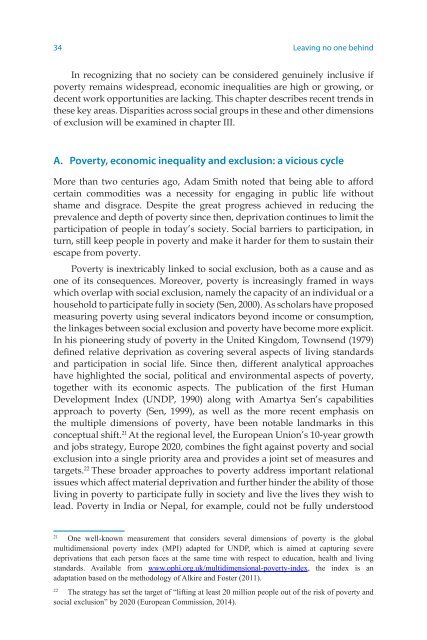Leaving no one behind the imperative of inclusive development
full-report
full-report
You also want an ePaper? Increase the reach of your titles
YUMPU automatically turns print PDFs into web optimized ePapers that Google loves.
34<br />
<strong>Leaving</strong> <strong>no</strong> <strong>one</strong> <strong>behind</strong><br />
In recognizing that <strong>no</strong> society can be considered genuinely <strong>inclusive</strong> if<br />
poverty remains widespread, eco<strong>no</strong>mic inequalities are high or growing, or<br />
decent work opportunities are lacking. This chapter describes recent trends in<br />
<strong>the</strong>se key areas. Disparities across social groups in <strong>the</strong>se and o<strong>the</strong>r dimensions<br />
<strong>of</strong> exclusion will be examined in chapter III.<br />
A. Poverty, eco<strong>no</strong>mic inequality and exclusion: a vicious cycle<br />
More than two centuries ago, Adam Smith <strong>no</strong>ted that being able to afford<br />
certain commodities was a necessity for engaging in public life without<br />
shame and disgrace. Despite <strong>the</strong> great progress achieved in reducing <strong>the</strong><br />
prevalence and depth <strong>of</strong> poverty since <strong>the</strong>n, deprivation continues to limit <strong>the</strong><br />
participation <strong>of</strong> people in today’s society. Social barriers to participation, in<br />
turn, still keep people in poverty and make it harder for <strong>the</strong>m to sustain <strong>the</strong>ir<br />
escape from poverty.<br />
Poverty is inextricably linked to social exclusion, both as a cause and as<br />
<strong>one</strong> <strong>of</strong> its consequences. Moreover, poverty is increasingly framed in ways<br />
which overlap with social exclusion, namely <strong>the</strong> capacity <strong>of</strong> an individual or a<br />
household to participate fully in society (Sen, 2000). As scholars have proposed<br />
measuring poverty using several indicators beyond income or consumption,<br />
<strong>the</strong> linkages between social exclusion and poverty have become more explicit.<br />
In his pi<strong>one</strong>ering study <strong>of</strong> poverty in <strong>the</strong> United Kingdom, Townsend (1979)<br />
defined relative deprivation as covering several aspects <strong>of</strong> living standards<br />
and participation in social life. Since <strong>the</strong>n, different analytical approaches<br />
have highlighted <strong>the</strong> social, political and environmental aspects <strong>of</strong> poverty,<br />
toge<strong>the</strong>r with its eco<strong>no</strong>mic aspects. The publication <strong>of</strong> <strong>the</strong> first Human<br />
Development Index (UNDP, 1990) along with Amartya Sen’s capabilities<br />
approach to poverty (Sen, 1999), as well as <strong>the</strong> more recent emphasis on<br />
<strong>the</strong> multiple dimensions <strong>of</strong> poverty, have been <strong>no</strong>table landmarks in this<br />
conceptual shift. 21 At <strong>the</strong> regional level, <strong>the</strong> European Union’s 10-year growth<br />
and jobs strategy, Europe 2020, combines <strong>the</strong> fight against poverty and social<br />
exclusion into a single priority area and provides a joint set <strong>of</strong> measures and<br />
targets. 22 These broader approaches to poverty address important relational<br />
issues which affect material deprivation and fur<strong>the</strong>r hinder <strong>the</strong> ability <strong>of</strong> those<br />
living in poverty to participate fully in society and live <strong>the</strong> lives <strong>the</strong>y wish to<br />
lead. Poverty in India or Nepal, for example, could <strong>no</strong>t be fully understood<br />
21<br />
One well-k<strong>no</strong>wn measurement that considers several dimensions <strong>of</strong> poverty is <strong>the</strong> global<br />
multidimensional poverty index (MPI) adapted for UNDP, which is aimed at capturing severe<br />
deprivations that each person faces at <strong>the</strong> same time with respect to education, health and living<br />
standards. Available from www.ophi.org.uk/multidimensional-poverty-index, <strong>the</strong> index is an<br />
adaptation based on <strong>the</strong> methodology <strong>of</strong> Alkire and Foster (2011).<br />
22<br />
The strategy has set <strong>the</strong> target <strong>of</strong> “lifting at least 20 million people out <strong>of</strong> <strong>the</strong> risk <strong>of</strong> poverty and<br />
social exclusion” by 2020 (European Commission, 2014).
















